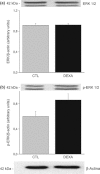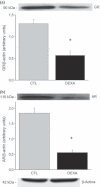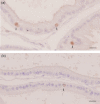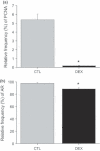Reduction of insulin signalling pathway IRS-1/IRS-2/AKT/mTOR and decrease of epithelial cell proliferation in the prostate of glucocorticoid-treated rats
- PMID: 22583132
- PMCID: PMC3385916
- DOI: 10.1111/j.1365-2613.2012.00817.x
Reduction of insulin signalling pathway IRS-1/IRS-2/AKT/mTOR and decrease of epithelial cell proliferation in the prostate of glucocorticoid-treated rats
Abstract
Previous studies by our research group using a model of insulin resistance induced by dexamethasone (DEX) showed that in the rat ventral prostate there was epithelial and smooth muscle cell atrophy and there were also alterations in fibroblasts. Proteins of the insulin signalling pathway are known to be very important for cell proliferation and development. Thus, we investigated the insulin signalling pathway and epithelial proliferation in the rat ventral prostate in this model and correlated the findings with expression of glucocorticoid (GR) and androgen (AR) receptors. Insulin resistance was induced in adult male Wistar rats by injection of DEX (1 mg/kg, ip for 5 consecutive days), whereas control (CTL) rats received saline. DEX treatment resulted in a significant decrease in body weight, but not in prostate weight. Reductions in insulin receptor 1 (IRS-1) (CTL 1.11 ± 0.06; DEX 0.85 ± 0.03), IRS-2 (CTL 0.95 ± 0.05; DEX 0.49 ± 0.04), AKT (CTL 0.98 ± 0.03; DEX 0.78 ± 0.02), mammalian target of rapamycin (mTOR; CTL 0.65 ± 0.08; DEX 0.22 ± 0.05), GR (CTL 1.30 ± 0.09; DEX 0.57 ± 0.10) and AR (CTL 1.83 ± 0.16; DEX 0.55 ± 0.08) protein levels were observed in the prostate of DEX-treated rats. The expression of the IRα-subunit, phosphoinositide 3-kinase, p-AKT, p70(S6K) , extracellular signal-regulated kinase (ERK) and p-ERK was not altered. The frequency of AR-positive cells in the epithelium of the prostate decreased in the glucocorticoid-treated group, and the intensity of the reaction for this receptor in the cell nuclei was lower in this group. Furthermore, the treatment with DEX reduced the frequency of proliferating cell nuclear antigen-positive (PCNA) cells 30-fold. This study suggests that the reduction in the insulin signalling pathway proteins IRS-1/IRS-2/AKT/mTOR in the prostate of DEX-treated rats may be associated with the morphological alterations observed previously.
© 2012 The Authors. International Journal of Experimental Pathology © 2012 International Journal of Experimental Pathology.
Figures







Similar articles
-
JNK and IKKβ phosphorylation is reduced by glucocorticoids in adipose tissue from insulin-resistant rats.J Steroid Biochem Mol Biol. 2015 Jan;145:1-12. doi: 10.1016/j.jsbmb.2014.09.024. Epub 2014 Sep 28. J Steroid Biochem Mol Biol. 2015. PMID: 25268311
-
Increased pancreatic islet mass is accompanied by activation of the insulin receptor substrate-2/serine-threonine kinase pathway and augmented cyclin D2 protein levels in insulin-resistant rats.Int J Exp Pathol. 2008 Aug;89(4):264-75. doi: 10.1111/j.1365-2613.2008.00588.x. Epub 2008 Apr 21. Int J Exp Pathol. 2008. PMID: 18429991 Free PMC article.
-
Dexamethasone impairs insulin signalling and glucose transport by depletion of insulin receptor substrate-1, phosphatidylinositol 3-kinase and protein kinase B in primary cultured rat adipocytes.Eur J Endocrinol. 2002 Mar;146(3):419-29. doi: 10.1530/eje.0.1460419. Eur J Endocrinol. 2002. PMID: 11888850
-
High-fat diet obesity associated with insulin resistance increases cell proliferation, estrogen receptor, and PI3K proteins in rat ventral prostate.J Androl. 2012 Sep-Oct;33(5):854-65. doi: 10.2164/jandrol.111.016089. Epub 2012 Mar 22. J Androl. 2012. PMID: 22441765
-
Protective Effects of Clenbuterol against Dexamethasone-Induced Masseter Muscle Atrophy and Myosin Heavy Chain Transition.PLoS One. 2015 Jun 8;10(6):e0128263. doi: 10.1371/journal.pone.0128263. eCollection 2015. PLoS One. 2015. PMID: 26053620 Free PMC article.
Cited by
-
(-)-Leucophyllone, a Tirucallane Triterpenoid from Cornus walteri, Enhances Insulin Secretion in INS-1 Cells.Plants (Basel). 2021 Feb 24;10(3):431. doi: 10.3390/plants10030431. Plants (Basel). 2021. PMID: 33668330 Free PMC article.
-
Role of corticosteroids in prostate cancer progression: implications for treatment strategy in metastatic castration-resistant patients.J Endocrinol Invest. 2016 Jul;39(7):729-38. doi: 10.1007/s40618-016-0430-z. Epub 2016 Jan 19. J Endocrinol Invest. 2016. PMID: 26786788 Review.
-
Blockade of insulin receptor substrate-1 inhibits biological behavior of choroidal endothelial cells.Int J Ophthalmol. 2019 Sep 18;12(9):1386-1394. doi: 10.18240/ijo.2019.09.03. eCollection 2019. Int J Ophthalmol. 2019. PMID: 31544031 Free PMC article.
-
3,3',4,5'-Tetramethoxy-trans-stilbene Improves Insulin Resistance by Activating the IRS/PI3K/Akt Pathway and Inhibiting Oxidative Stress.Curr Issues Mol Biol. 2022 May 12;44(5):2175-2185. doi: 10.3390/cimb44050147. Curr Issues Mol Biol. 2022. PMID: 35678676 Free PMC article.
-
Corticosterone influences gerbil (Meriones unguiculatus) prostatic morphophysiology and alters its proliferation and apoptosis rates.Int J Exp Pathol. 2017 Jun;98(3):134-146. doi: 10.1111/iep.12232. Epub 2017 Jun 29. Int J Exp Pathol. 2017. PMID: 28664583 Free PMC article.
References
-
- Briaud I, Lingohr MK, Dickson LM, Wrede CE, Rhodes CJ. Differential activation mechanisms of Erk-1/2 and p70(S6K) by glucose in pancreatic beta-cells. Diabetes. 2003;52:974–983. - PubMed
-
- Burén J, Liu H, Jensen J, Eriksson JW. Dexamethasone impairs insulin signalling and glucose transport by depletion of insulin receptor substrate-1, phosphatidylinositol 3-kinase and protein kinase B in primary cultured rat adipocytes. J. Endocrinol. 2002;146:419–429. - PubMed
-
- Cagnon VHA, Camargo AM, Rosa RM, Fabiani CR, Padovani CR, Martinez FE. Ultrastructural study of the ventral lobe of the prostate of mice with streptozotocin induced diabetes (C57bl/6j) Tissue Cell. 2000;32:275–283. - PubMed
-
- Carvalheira JBC, Calegari VC, Zecchin HG, et al. The cross-talk between angiotensin and insulin differentially affects phosphatidylinositol 3-kinase- and mitogen-activated protein kinase-mediated signaling in rat heart: implications for insulin resistance. Endocrinology. 2003;144(12):5604–5614. - PubMed
Publication types
MeSH terms
Substances
LinkOut - more resources
Full Text Sources
Medical
Research Materials
Miscellaneous

